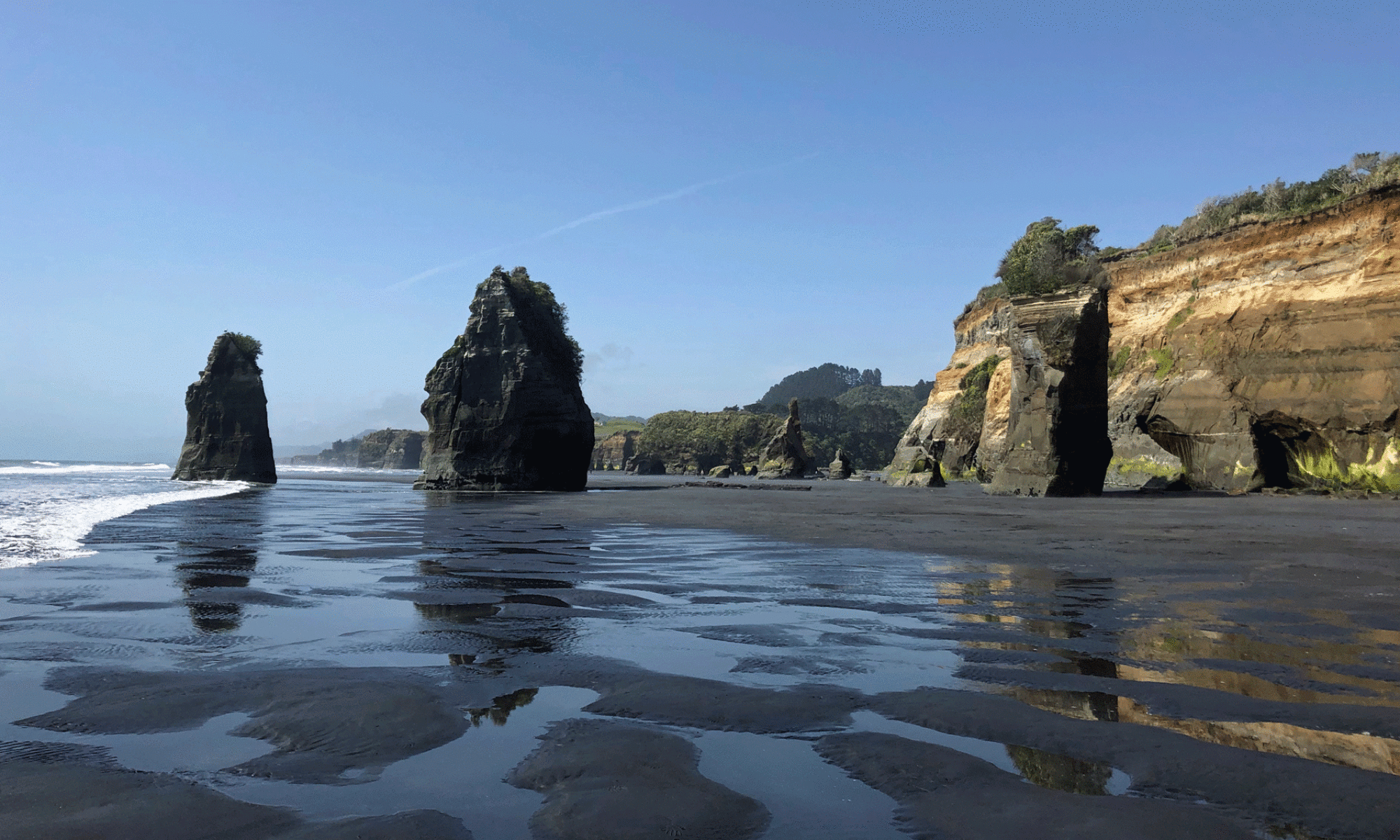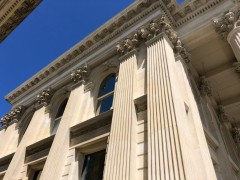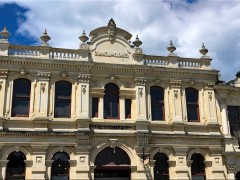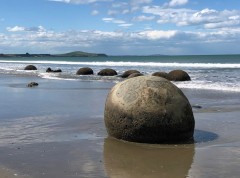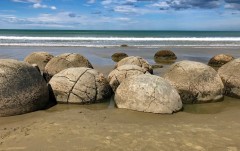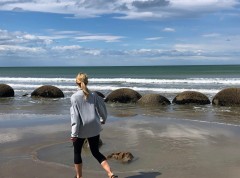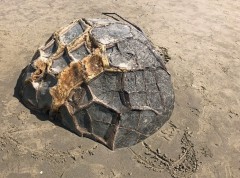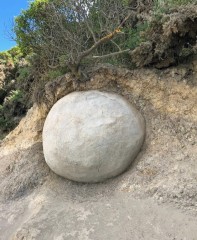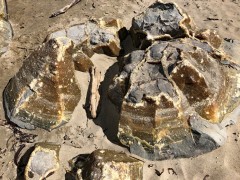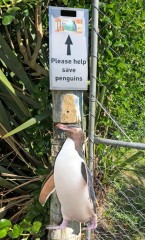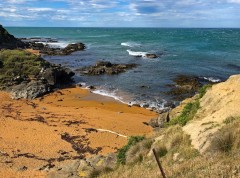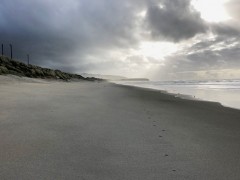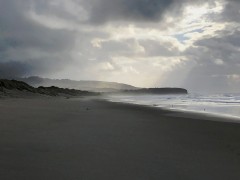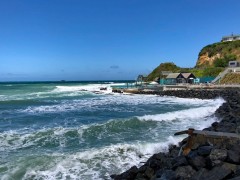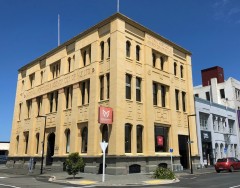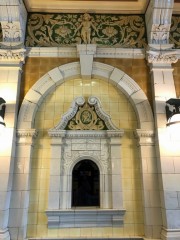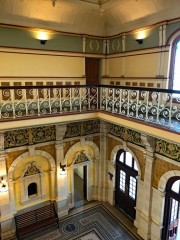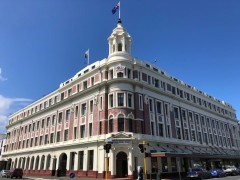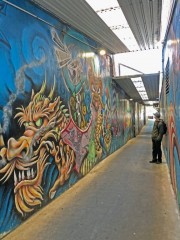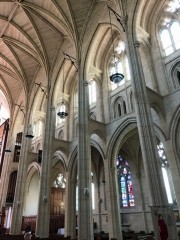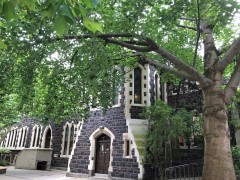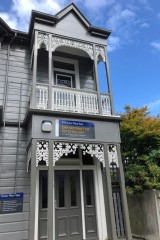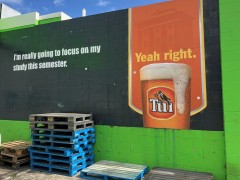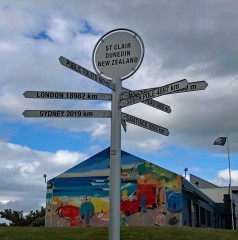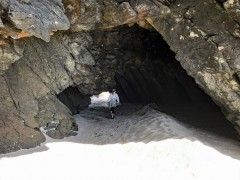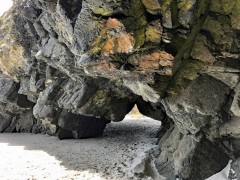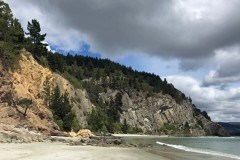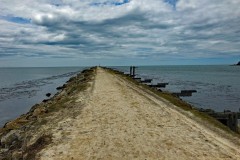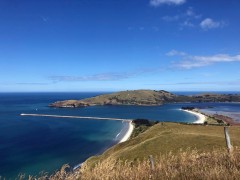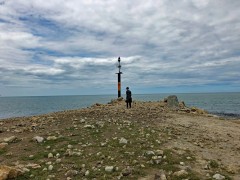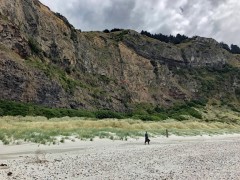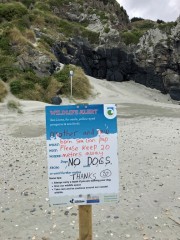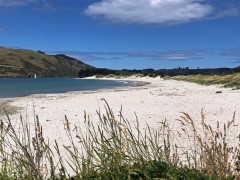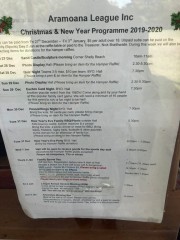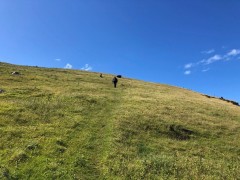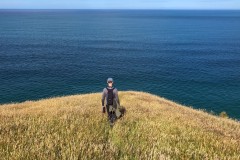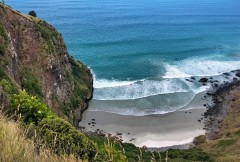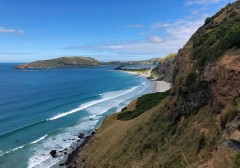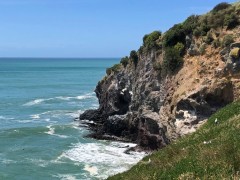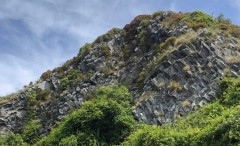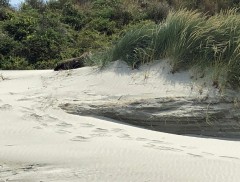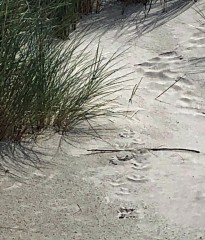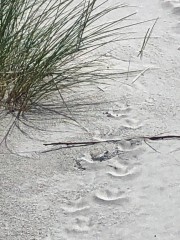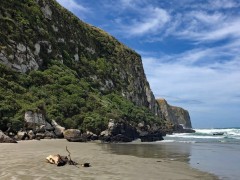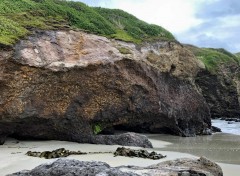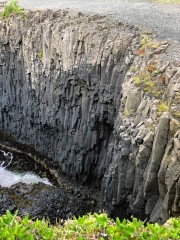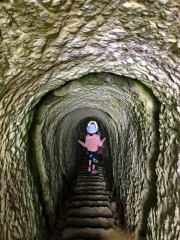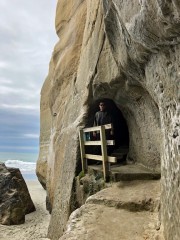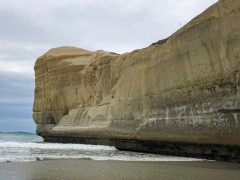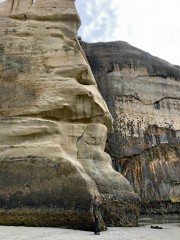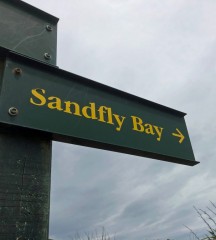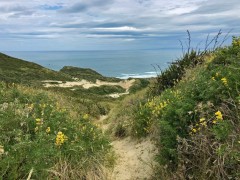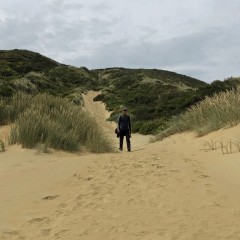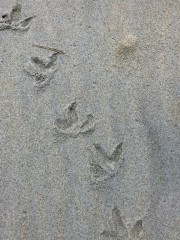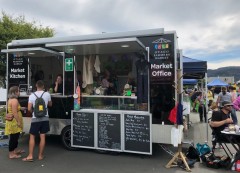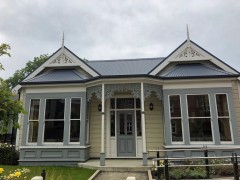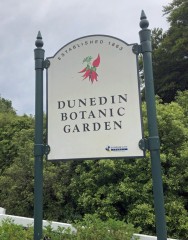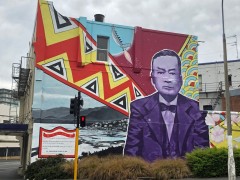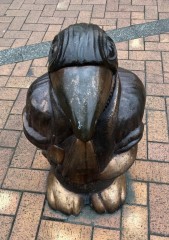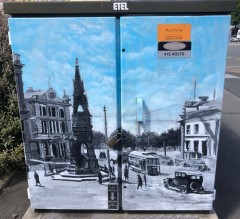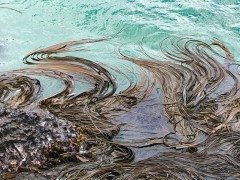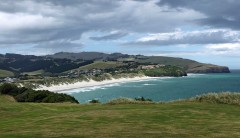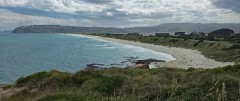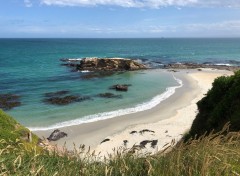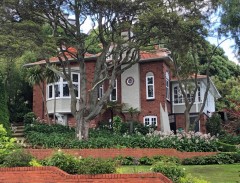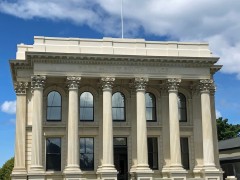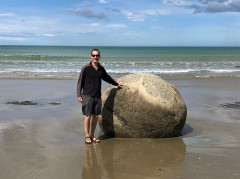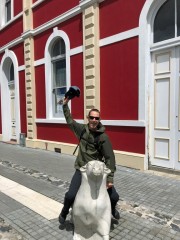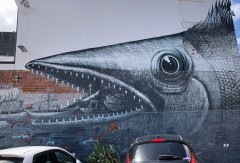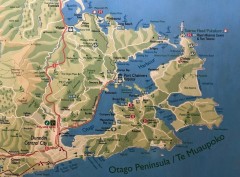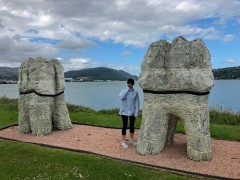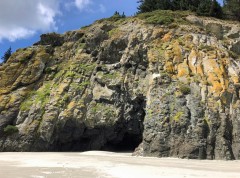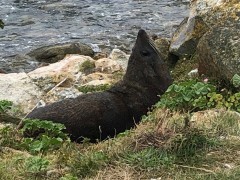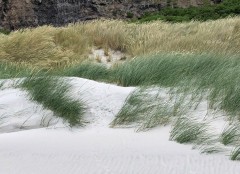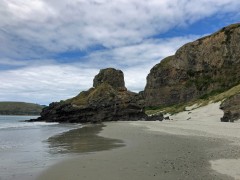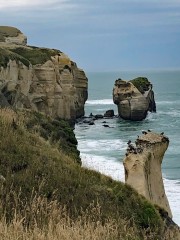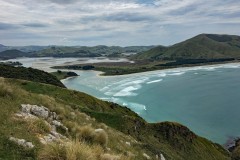Gaelic for Edinburgh
Dunedin, a city of around 130,000 people about 350 km south of Christchurch, is famous for its Scottish heritage, grand architecture, the oldest university in NZ, wildlife-filled Otago Peninsula and cold rainy weather. Happily, we were able to experience and enjoy the first four of these without suffering too much from the last.

Monday – Move Day
Heading south out of Christchurch, there aren’t a lot of attractions so the first couple of hours went by quickly with fairly straight, flat driving which facilitated a nice catnap for me. We made a short stop in Timaru for a walk along the boardwalk on their pretty curve of a beach butting up to their port.
Soon we were in Oamaru, known for its white stone buildings that were built with local limestone during the town’s glory days of the gold rush. Strangely enough, this is also home to a Steampunk movement and museum. After a wander, we diverted from Hwy 1 for a beautiful coastal drive, complete with picnic, on south to Kakanui, where we’ll be coming back to stay a few days in late February. It’s a beautiful, quiet area and we’re already looking forward to it as a respite from the heavily touristed areas we’ll be in during late January and early February.

We made the must-do stop at the Moeraki boulders, large rock spheres which have formed like pearls around fossils, and surprised ourselves with just how interesting they were – especially the cracked open ones. The predicted hordes of tourists were there, but really only about 50 people and then a five minute walk north of the main attractions took us to more where there was no one but us.

The wind was absolutely fierce today, with a gale of 130 km/h gusts along this coast and in Dunedin where we were headed. The driving had gotten worse throughout the day and this was when it really started to kick in.
Despite that, we could not resist stopping at Katiki Point lighthouse. This remote headland is home to both a penguin and a sea lion colony and we saw both! Yes, our first penguins of the trip and they are the very rare Yellow Eyed Penguins. They seem very large to me, having only seen fairy penguins before, and they are Hale’s first ever. We can’t stay for dusk where we’d really get to see some activity, but we’ll do that in Feb when we are staying within an hour’s drive. These two were just hanging out in a wind shadow, alternately preening and laying down for a rest.

Another stop at the remote Shag Point, but the wind was such that we could barely stand up, let alone enjoy hanging out to watch the seals play. We saw the phenomenon of “smoke on the water” as whole patches of the ocean are so windblown that the air above the whitecaps is just swirling water vapor. We carried on south to Dunedin through high winds with hope that we wouldn’t get hit by a falling tree. Sure enough, we came upon one spot where they were just clearing one from the highway and upon arrival in Dunedin we heard about someone hospitalized after a tree fell on her.
It was late by the time we met our lovely host Claire and settled into our apartment for the week – a side section of an old home on a hill overlooking St Clair, Dunedin’s south side beach.
Tuesday
For some crazy reason, I decided a morning walk was a good idea despite the pelting rain and I walked the short distance down to the beach. A surf competition that had to be canceled yesterday due to the conditions was starting up this morning at 7 despite the rain and cold temperatures. St Clair is a beautiful beach with cliff on both ends and a 3.5km long stretch of beautifully packed white sand backed by preserved coastal dunes rising up behind it. Walking all the way to the end was delightful, but returning into the cold rain and wind left me freezing and I was happy to get home to the heater, a cuppa and a blanket.

We spent the day exploring Dunedin, seeing many sides of it as we wandered the various areas. Starting with the working side of the city, we walked from the beachside suburb of St Clair through the industrial and commercial South Dunedin, then into the city center with its grandiose Victorian and Edwardian architecture including the famous train station, where we had a chilly picnic on the front lawn, and its similarly grand churches and government buildings surrounding the lively octagon and its cafes.

Through the long tourist street (ick – a Starbucks across from a McDonalds!) and to the historic Otago University, New Zealand’s oldest, with its mix of beautiful heritage bluestone buildings and modern additions. Then along Leith Street with its grotty party student flats and down to the port and eventually the harbour where we followed a bike path out to the base of the Otago Peninsula and then across to St Kilda (another beach suburb) before heading home.

This may be the day we decided that winter in NZ is not right for us considering we were shivering most of this mid-summer day!
Wednesday
A beautiful morning with the front finally moving north and leaving clear southern light and blue skies. We found a great coffee roaster, Grid, in the hillside Mornington neighborhood. This is clearly where the wealthy lived in the early (and present) days of Dunedin, based on the mansions and the beautiful views over the city, harbor and peninsula.

The Otago Peninsula, which forms the southern side of Dunedin’s very deep harbor, is famous for its walks and wildlife but we headed to the northern arm of the harbor instead, for a quieter, non-commercialized experience on this day. A great choice. We saw very few other tourists and thoroughly enjoyed the areas we explore.
First up was Doctors Point Reserve where the beaches are white sand, backed by cliffs, sea caves and pine trees. The scenic “Seaside” train runs along these cliffs, a statement to the beauty of the area.

After a stroll here, we drove across to Port Chalmers. This is the main port for Dunedin and the port is literally right on the main street. It is startling to look down the street and see: “shop, pub, shop, museum, containers” but it works and it’s actually a thriving and charming small town. There was both a container ship and a cruise ship in port and later in the day we watched them both steam out to sea.

A curvy road hugging the shoreline took us out to the tiny village of Aramoana* where we spent the rest of the day going all directions from the carpark. First south along a sandspit that divides the ocean from the bay. Here we saw two seals mostly covered in sand sleeping on the beach and a tour boat pointing one out to his passengers.
Then west, out on “the mole.” This is a breakwater that stretches out in the ocean, paralleling the famous Otago peninsula head to form the harbor mouth. What’s exciting is the chance to see royal albatross flying overhead on their way to their colony there (we don’t have such luck) and sea lions resting on the breakwater rocks. We were delighted to see two of them – our first up close sea lions of this trip. They are different from seals and not found on the north island. They have whiskers and manes and are more aggressive than seals, plus they are enormous. These two were just lazing around posing though.

Then east, along the ocean beach. This is a stunningly beautiful beach, with rock formations, high red cliffs, seashells galore, white sand and beautiful dunes filled with waving green grasses. What’s best though, is the life on these beaches. Sea lions, nesting birds and penguins. We saw the first two and evidence of the penguins in their tracks left on the beach from where they make their way from the sea to their nests in the dunes.

After a picnic watching kiwi families swim in their wetsuits (did I mention it is cold down here?), we took our last (and best) walk of the day – up. This is a steep hike to the coastal headland above the ocean beach, through sheep pastures, pine forests and high grass bush with astounding views of the tidal bay, the ocean, the Otago Peninsula and all the places we have explored earlier in the day. At the end of the track, we reached the point and gazed down the beach from high, high above, watching seals swim in from sea and surf the waves onto the shore.

*We later learn that Aramoana has a much bigger recent history than you would imagine for such a tiny and seemingly carefree place. It was the proposed site of a major smelt that was successfully fought off (over decades) by the residents – a heartwarming story.

The other infamous event has nothing heartwarming about it, as we later learn from our host Claire. Aramoana was home to New Zealand’s worst mass shooting in 1990 (a record broken this year by the horrors of Christchurch) when a local man killed 13 people. The only bright side of this is that New Zealand promptly reacted, imposing strict gun licensing laws and outlawing military-style semi-automatic weapons.
Thursday
Cloudy morning, so a slow start before we got in gear and drove out to the Otago Peninsula. As advertised, it is indeed very pretty with pastures, hills, one lane roads and ocean views. We stopped to check out Harwood for a possible kiting session, but the wind was too gusty and offshore.
Otago Peninsula is known for being the only Royal Albatross nesting area on a mainland in the world. This is in addition to being a haven for Coopers Sea Lions, Little Blue Penguins and the very rare Yellow Eyed Penguins. (Supposedly also rare seagulls, which don’t seem rare since we see them everywhere, squawking away at each other and us.) We drove out to the tip of the peninsula to this sanctuary and thoroughly enjoyed the informative and interesting museum within the gift shop. Amazing what one couple (Lance and Agnes Richdale) did for these birds.

We managed to escape without gull droppings on our heads and drove a slight ways down the peninsula to the Okia Reserve. This track starts off with close-ups of the “pyramids” which are (as you might guess) pyramid shaped rock formations, with a very cool rocky rosette in the larger one. Then through grassy bush out to a deserted beach where we were extremely saddened to see not only live sea lions, but two dead seal pups and even worse due to their rarity, a dead Little Blue Penguin. I photographed and reported these to DOC since they track deaths in case of mass die offs like they had a couple of years ago, but I’ll spare you the photos.

A quick bite to eat along the harbor and then we were back to Dunedin. I finished the day with a much more pleasant St Kilda/St Clair beach walk. Evening is spent finally deciding that we’re not going to take the known goodness of NZ again next Oct-April and instead try something new. Exactly what, we haven’t figured out yet but since we’ve been sitting on the fence about a return to NZ for months now, this is a big decision in and of itself.
Friday
Another Otago Peninsula day, but first a jaunt south to beautiful Tunnel Beach. This is a track that reaches the beach through a tunnel that a dad commissioned through the cliffs so his daughters could reach the beach. I thought it would be cool to see that, but was completely unprepared for the beauty of the cliffs, rock formations and enormous sea arch in the immediate area. As a well-known spot, there were lots of people but that didn’t mar the experience.

This time on the peninsula we went straight to Sandymount Track. On the east side of the peninsula, it promises viewpoints over Lovers Leap and the Chasm, but we learn midway through the hike that both of those were removed in June 2019 due to land instability. The wonderful DOC built a new lookout over Allan’s Bay though so we weren’t too disappointed.

From the same trailhead, we hiked through massive sand dunes down to Sandfly Bay. Anyone who knows me knows that biting bugs love me as much as I hate them and New Zealand’s sandflies are a form of black fly with teeth that tear into your skin leaving bites that can itch for months. So when I first heard about this beach, I was sure I would not be visiting it. Turns out the name comes from the fierce winds that funnel through the surrounding cliffs whenever a southerly blows. The wildlife you can expect to find there is of the sea lion and yellow eyed penguin variety. We didn’t spot any penguins, but enjoyed multiple sea lions lounging around and doing their usual posturing. It was a workout getting back up the giant dune and we were done for the day.
Saturday
Dunedin has a fantastic Otago Farmers Market right next to the train station and we quickly filled our bag with fresh stone fruit and locally produced blue cheese. A wander around town together then Hale headed home for promenade chilling while I walked to the Botanic Gardens and along the town green belt, exploring the various neighborhoods that ring the hills of the city.

We then had a very fun late afternoon into nighttime session on the patio sharing stories with our interesting and welcoming kiwi hosts Claire and Aaron. By evening’s end, Hale had received two hongi (Maori greeting), a meaningful one from Aaron and a delightfully silly one from Banksy, their sweet and enormous Bouvier des Flandres.
Sunday
A relaxing last day in Dunedin. Delicious flat whites at Vanguard Coffee, surrounded by street art. Hanging out on the promenade watching the surfers and putting together a list of all the places in the world we want to visit someday. Long beach walk to the lookout for Susan and a quiet evening at home.
Wrap
We enjoyed our time in Dunedin and again, it was nice to have so much in walking and short driving distance where we were able to spend more time doing or relaxing than in some of our other locations. Dunedin and its surroundings have so much to offer that we were surprised to hear from our hosts that very few Americans make it this far south on the east coast – most heading straight over to Queenstown and Fiordland from Christchurch. I’m glad we didn’t make that mistake.
Week 12 of our journey
